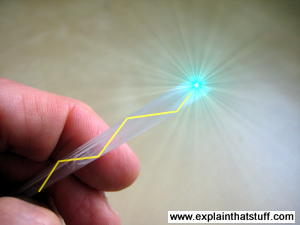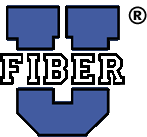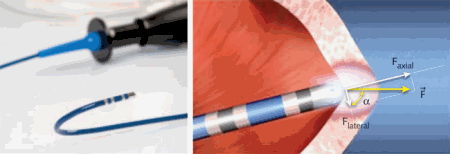No one gave a better perspective on the almost unimaginable way fiber optics work and how ubiquitous they have become than this fiber optic pioneer from Abilene TX; “they are like ATM machines, there is so much going on behind the curtain, that most of us don’t ask any questions about them. Few of us could ever have conceived of how easy, accurate and safe it would be to access our money from a machine in a building wall . We don’t want the details, just the money! Similarily, with fiber otptics, most don’t understand how they work, just that they do work! We don’t want the details, just the connection…” 
Although if so inclined, you really can learn about the magical workings of fiber optics at www.fiberu.org . You will find a wealth of information and helpful links. I first encountered the world of fiber optics thru this same aforementioned pioneer in Abilene TX. I was working for Anaconda, at that time owned by Atlanitc Richfield. Anaconda manufactured the conduit that housed the fiber optic bundles. It was then the late 1970s and early 1980s, when telephone companies began to use fibers extensively to rebuild their communications infrastructure. Sprint was actually founded on the first nationwide, 100 percent digital, fiber-optic network in the mid eighties. He was a local contractor who became extremely successful and made mucho $$$ laying the fiber optic network for AT&T.
This past February, the Economic Development Council of Western Massachusetts hosted an event, New Market Opportunities for Photonics and Fiber Optics Companies”. The key note speaker was John Jay Market Development Manager for Corning Fiber Optics. His presentation was terrific and touched on how E-commerce has made the data center the factory of the 21st century. Fishman®‘s customer’s in fiber optics include suppliers to these massive data centers, as well as;
- Fishman® is now being solicited by US Government Prime Contractors to package our SmartDispenser as a remote repair fiber optic re termination kit for use by bases, depots and aircraft carriers around th
 e world. The kit has to be portable(can’t require compressed air), and most importantly, the re termination of an FO cable in an aircraft and submarines has to be done with extreme precision and repeatability; from country to country, base to base, ship to ship, plane to plane.
e world. The kit has to be portable(can’t require compressed air), and most importantly, the re termination of an FO cable in an aircraft and submarines has to be done with extreme precision and repeatability; from country to country, base to base, ship to ship, plane to plane.
- Analysts at IGI Consulting say in a study that the military and aerospace avionics market for fiber optics components, subsystems, and systems will more than double by 2013, growing to $703 million in 2013. The increase is due to factors such as greater acceptance of this new technology driven by the rapid acceptance and developments in the telecommunications field, the need to reduce size, weight and power and the need for higher bandwidth,
- Despite the desire to use more fiber in aircraft, specific military and aerospace requirements present major barriers such as the unavailability of commercial off-the shelf technology, lack of hardened components for the military and aerospace environment, available test and maintenance procedures, and the availability of low cost, easy to use test and measurement equipment, IGI analysts say.
- IGI analysts also say that more flexibility needs to be built into smart wiring systems to reduce cost of retrofits and upgrades and maintenance by using built in test equipment and continued research is needed in standards, test equipment, integrated optical components, manufacturing technology, and testing and hardening of fiber optic systems.
Many of Fishman®‘s medical device customers use fiber optics in the manufacturing of their catheters .
This article by Alexis Mendez President of MCH Engineering LLC states it well; as the global population that’s both growing and living longer, the world’s healthcare providers are increasingly looking to advanced biomedical instrumentation to enable more efficient patient diagnosis, monitoring, and treatment. In this context, biomedical sensing applications of optical fiber are of growing importance. At the same time, recent advances in minimally invasive surgery (MIS) demand smaller disposable sensing catheters. The biomedical sensing market represents a lucrative and growing opportunity for FOS( fiber optic sensors), particularly for large volumes of disposable probes. The demand for more patient monitoring devices combines with a trend toward minimally invasive surgery, which itself requires a variety of minimally invasive medical devices as well as single-use, disposable sensors of small size that can be incorporated into catheters and endoscopes—an ideal fit for fiber-optic sensors.
- For example; the picture below shows a fiber-optic intra-aortic force sensing catheter probe enables real-time monitoring of the force
 exerted against the heart wall by the catheter. (Courtesy of EndoSense)
exerted against the heart wall by the catheter. (Courtesy of EndoSense)
Our favorite fiber optic application here at Fishman® is the the occasional fiber optic sculptor, whose quest for precison, repeatabilty and perfection of fluid dispensing needed to assemble his art, is set as high as those at NASA!





